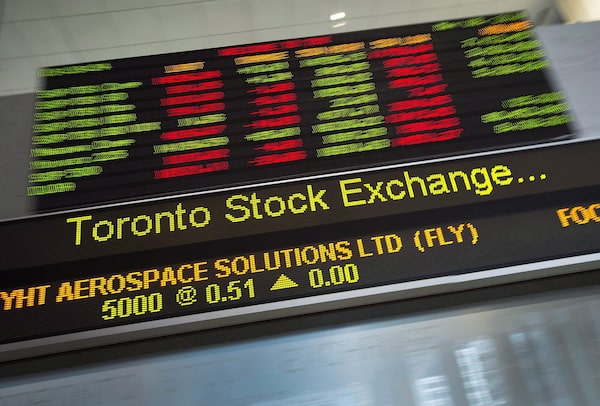
The S&P/TSX closed lower for more than half of the trading sessions in the three months ended Dec. 31, 2018.Darren Calabrese/The Canadian Press
In recent months, stocks have been hammered with equity markets repeatedly experiencing a string of triple-digit losses. The S&P/TSX Composite Index posted a loss of 11 per cent in the final quarter of 2018, the worst performing quarter since 2008 when the Canadian economy was officially in a recession. The S&P/TSX closed lower for more than half of the trading sessions in the three months ended Dec. 31, with single-day losses exceeding 1 per cent nearly 20 per cent of the time. Algorithmic trading fuelled intraday volatility, tax-loss selling added to the downward pressure and buyers simply stayed out of the markets. Even company insiders appeared hesitant to make meaningful purchases despite depressed stock prices and low valuations.
The intense market volatility has been driven by a number of factors including recession fears, tightening monetary policy, concerns over decelerating earnings growth, slowing domestic and global economic growth, a flattening yield curve that is close to inverting, the collapsing price of oil and trade uncertainties with China.
The S&P/TSX is now trading at levels last seen in 2016 and at a forward price-to-earnings multiple of about 13 times the consensus 2019 estimate – a level not seen since 2012. Is the stock market now close to a bottom or is there a further downside? How should investors position their portfolios in the current environment?
The Globe and Mail interviewed three industry pundits who outlined their market outlooks, which may help investors navigate potential market volatility in 2019.
Ian de Verteuil, head of portfolio strategy at CIBC World Markets
With a tepid outlook for the Canadian stock market, Mr. de Verteuil stresses that investors should be increasingly defensive given the expected heightened market volatility.
“I think equity returns are going to be modest, hopefully positive, and that being overweight cash is a good investment decision.” He notes: “You can buy a T-bill from the Government of Canada that will give you a yield of 1.7 per cent. You can buy one-, three- and five-year bonds from a variety of very high-quality issuers and probably get your yield up to 3 or 4 per cent, and I think that is quite a reasonable return. I would view that as an incredibly low-risk way of earning some returns in a very volatile period. I think we are in a very uncertain time and whatever your risk tolerance is, you should skew toward being quite a bit more defensive with higher levels of cash.”
His cautious position is driven by two main factors. “The first thing is that we are operating at unusually low levels of interest rates. Raising interest rates after a period of incredibly loose monetary policy is a risky environment. The other thing is [that] trade is very uncertain at this point.”
He believes the major sectors in the S&P/TSX – financials, energy and gold – may all add value to a diversified portfolio. “I think energy stocks, after a very difficult 2018, will have a much better 2019. I think bank stocks will generate pretty reasonable returns. They will probably grow earnings somewhere between 3 and 8 per cent and you’ll get a dividend yield of 4 per cent. In an environment of uncertainty, owning some gold stocks is a good ballast and provides good defence.”
Luc Vallée, chief strategist at Laurentian Bank Securities
Taking an opposing position, Mr. Vallée believes now is the ideal time for investors to reduce cash positions and buy stocks, given their attractive valuations.
“This is the greatest time to invest in the Canadian stock market. We recognize the threat of the trade war and interest rates being increased by central banks. We will not start the year strongly because this uncertainty will not be quickly resolved but eventually we will get out of this pessimistic narrative. We have the TSX at 18,500 at the end of the year and for the end of 2020, we have it at 20,000. People are looking at these numbers and saying they are very high, but this summer the TSX was above 16,500, now we are around 14,000. This is overly pessimistic. In November and December, that was the time to hold cash but as I see the markets falling, I would certainly start deploying my cash now, not in one shot.”
Murray Leith, director of investment research at Odlum Brown
Mr. Leith recommends investors remain fully invested throughout this market turbulence.
“I don’t believe in market timing. Investing is a marathon, not a sprint, and necessitates a longer-term view to do well,” he says. "You don’t need to make many mistakes to really undermine your long-term performance. You miss a year when the market is up 20 per cent, it just doesn’t cost you that 20 per cent, it costs you every year thereafter when you don’t make money on that 20 per cent, so there is a compound penalty for trying to time the market and getting it wrong.”
In terms of financial planning, Mr. Leith compares investing in the stock market with home ownership. “People make incredible money on their house over time because they do not trade it all the time. That is why people generate most of their wealth through the equity in their home. Most people do poorly in the stock market because they are emotional and they jump in and out at the wrong time.”
His advice to investors: Be broadly diversified. “We prefer high-quality businesses with great management that have sustainable competitive advantages.”
 Jennifer Dowty
Jennifer Dowty